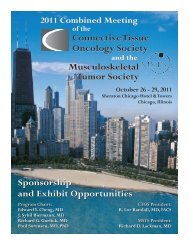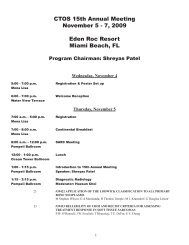207 Poster Session 2 - Connective Tissue Oncology Society
207 Poster Session 2 - Connective Tissue Oncology Society
207 Poster Session 2 - Connective Tissue Oncology Society
Create successful ePaper yourself
Turn your PDF publications into a flip-book with our unique Google optimized e-Paper software.
Scientific <strong>Poster</strong>s – <strong>Poster</strong> <strong>Session</strong> 2Yi Qian 13 ; Ira Jacobs 131University Claude Bernard Lyon I, Lyon, France; 2 Sarcoma<strong>Oncology</strong> Center, Santa Monica, CA, USA; 3 MusculoskeletalRadiology, UCLA School of Medicine, Los Angeles, CA,USA; 4 Georgetown University College of Medicine,Washington, DC, USA; 5 Massachusetts General Hospital,Boston, MA, USA; 6 Royal Orthopaedic Hospital,Birmingham, United Kingdom; 7 Istituti OrtopediciRizzoli, Bologna, Italy; 8 HELIOS Klinik Berlin-Buch, Berlin,Germany; 9 Maria Sklodowska-Curie Memorial Cancer Centerand Institute of <strong>Oncology</strong>, Warsaw, Poland; 10 University ofMichigan, Ann Arbor, MI, USA; 11 Peter MacCallumCancer Centre, East Melbourne, VIC, Australia;12Hospital Sant Pau, Barcelona, Spain; 13 Amgen, Inc.,Thousand Oaks, CA, USAObjective: Giant cell tumor of bone (GCTB) is a rareosteolytic tumor that tends to be locally aggressive. Currently,no standard therapy exists for patients (pts) withunresectable or metastatic GCTB, and no well-establishedtumor response criteria are available for evaluating GCTBtreatments. The aim of this analysis was to provide anindependent imaging assessment of tumor response forpatients (pts) in a phase 2, open-label study of denosumab120 mg (Q4W) for the treatment of GCTB, based on prespecifiedresponse criteria.Methods: Objective tumor response (OR; complete or partialresponse) was evaluated retrospectively by an independentimaging facility (CoreLab Partners, Inc.) for patientswho had CT, MRI, PET, or PET/CT as part of their standardof care. OR was summarized based on the best responseusing one of the following criteria: Response EvaluationCriteria in Solid Tumors (RECIST) v1.1, to evaluate tumorburden based on the size of lesions on MRI or CT scans;modified European Organization for Research and Treatmentof Cancer (EORTC) to evaluate metabolic responsebased on Standardized Uptake Value by Body Weight(SUVbw) on PET scans; and modified, inverse Choi criteriato evaluate lesion density and size using Hounsfield unitsbased on CT or MRI. Duration of response was evaluatedin pts who had an OR, and durable responses were evaluatedin patients with ≥ 2 evaluable time point responsesthat were at least 12 weeks apart.Results: A total of 190 patients had ≥ 1 evaluable timepoint response. Patients were 55% female, age 35 (SD 13)years. An OR was observed in 136 patients (72%) basedon the best response with any criteria (25% [47 of 187] forRECIST; 96% [25 of 26] for EORTC; and 76% [134 of 176]for Density/Size). The median (95% CI) time to OR was3.1 months (2.9, 3.7). A total of 76 of 111 (69%) patients hadOR sustained for up to 24 weeks, and 139 of 144 (97%)patients had tumor control (complete or partial responseor stable disease) sustained for at least 12 weeks, basedon the best response using any tumor response criteria. Atotal of 179 of 190 patients (94%) had no disease progressionbased on imaging criteria alone. The median time todisease progression was not reached at a median follow-upof 13.4 months.Conclusion: In the first independent imaging assessmentof a GCTB therapy to date, the majority of patients whoreceived denosumab had a sustained, objective tumorresponse and tumor control. Denosumab continues to bestudied as a potential treatment for GCTB.<strong>Poster</strong> #143INTRALESIONAL RESECTION MARGINS IN BONESARCOMAS: WHY AND WHAT IS THE OUTCOME?Amit Kotecha; P. Fenton; A. Abudu; R. Tillman; S. Carter;R. Grimer; Lee JeysRoyal Orthopaedic Hospital, Birmingham, United KingdomObjective: The aim of study was to find out the rate, causativefactors and outcomes of intralesional margins on bonetumour from a large series of primary bone tumour.Methods: 3514 bone sarcoma from 1970 and 2011, 2780were newly diagnosed. Inclusion criteria were; a) Detailedknowledge of surgical and pathological margins. b) Detailsof surgical procedures , leaving 1955 patients in the studygroup.Results: The rate of intralesional margins significantly variedby diagnosis with Adamantinoma 31%, chondrosarcoma28%, chondrosarcoma 25%, chordoma 19%, de differentialewings 9%, osteosarcoma 8%, other 15%. It was significantlylower in tumour where chemotherapy was used and outof all Intralesional margin of resection 70 % of cases wereobserved in cases with poor tumour necrosis (less than 90%tumor necrosis, p= 0.04). The rate also varied by operationtype with Amputation 7%, EPR 16%, Excision alone 25%.The frequency of local recurrence as increased with narrowermargins (Intralesional 35%, Marginal 21%, Wide 12%,wide contaminated 32%, p=0.0001). The 5 year survivalfollowing wide contaminated margin 32%, intralesionalresection was 49%, marginal 54%, and wide 70%.Pathologicalfracture at presentation did not significantly affect themargins ( around 10 % in all margins group).In the Intralesional group: majority did not have immediatesecond operation(83%) whilst 9% had re- excision, 2% hadamputation, 5% had an EPR, !% had curettage. Eventualoutcome was no further operation in 58%, EPR in 11%, reexcisionin 16, and amputation in 15%. The patients hadlocal recurrence, 36% had amputation, 33%had no furthersurgery and 31% had further limb salvage surgery. Localrecurrence significantly reduced survival in intralesionalgroup.238






